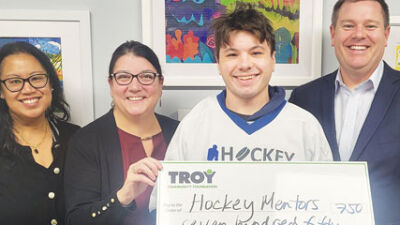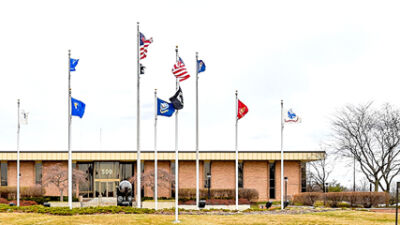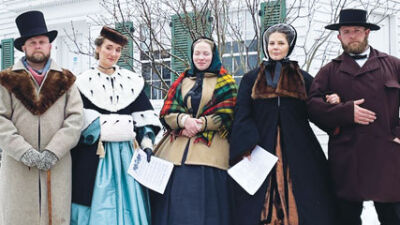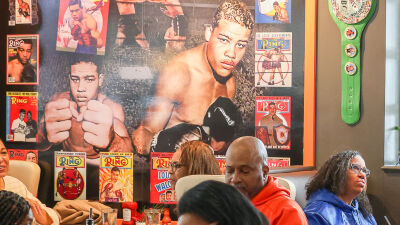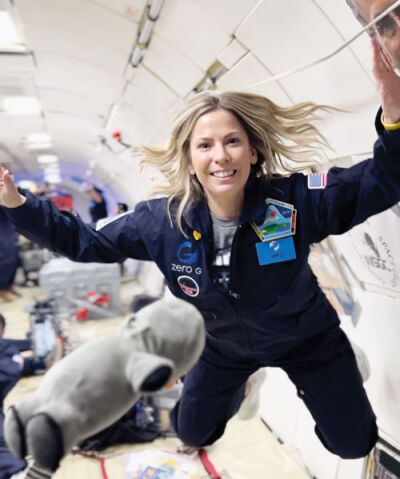
Using a specially designed cargo plane flying in parabolic arcs, passengers like Larson Middle School teacher Colleen Cain, pictured, can experience zero gravity.
Photo provided by Colleen Cain
TROY — One Troy teacher flew high and went on an out-of-this-world trip to benefit her students.
Colleen Cain, a Rochester Hills resident, is a seventh grade science teacher at Larson Middle School in the Troy School District. On March 7, she took part in the Wisconsin Space Grant Consortium and the Zero Gravity Corp.’s Embedded Teacher Program and was one of eight educators from across the country to perform experiments they designed with their students in zero gravity.
The feat is achieved by flying the teachers in a specially designed cargo plane that performs high-altitude parabolic dives, thus creating a weightless environment for intervals of about 20 to 30 seconds.
“I did this Thursday. It’s a group of eight teachers from around the country. We went to Fort Lauderdale. We did a test readiness review where we explain our experiments, they review them, and we make sure they are flight-ready,” explained Cain.
“We prepped all week. We boarded the plane, and it takes about 15 minutes as the modified Boeing 727 ascends. It only has a few rows of seats, and the rest of it is open. Then we got out of our seats and prepared our experiments. Then we did parabolas. We needed a really detailed flight matrix, so we knew what we would do on each parabola. We laid flat on the ground. They tell you to stare at one point, you have two G’s of force on you. The first two parabolas were in lunar gravity. I expected to feel lighter, but it was so much different. I did a sort of moonwalk. The experience of weightlessness only lasts 20 to 30 seconds. Then we did 28 parabolas of microgravity, which is weightlessness. During those microgravity parabolas, we did our experiments.”
Her flight mentor who prepared her for the flight was Laura Tomlin, the founder of Space for Teachers, which works with the Wisconsin Space Grant Consortium to prepare the teachers for such flights. A fellow middle school science teacher from Salado, Texas, she helped Cain and the others prepare for their exciting flight.
“I am an educator also. I did a flight myself a few years ago,” she said. “Now I mentor other teachers for the program. It’s a yearlong process. I have been working with Colleen for about a year and half, since the flight got pushed back. We start with a workshop teaching them the basics of microgravity and begin planning the experiments. We meet once a week and discuss experimental design and help them navigate the process with their students. We help them through the whole process, including the paperwork, hazardous materials clearance, and so forth.”
Cain’s flight was originally scheduled for last May but was delayed. However, this did mean both her class from this year and her class from last year were able to contribute to the project.
“We had three experiments. One focused on density and how microgravity impacts how different materials mix when they have different densities. This is like how oil and water don’t mix. We created tubes of liquids mixing in microgravity,” she said.
“We also did an experiment about polymers, where students made a sort of polymer slime bouncy ball. We used a sensor to measure the bounce in microgravity. We wanted to see if it would still bounce in microgravity. This didn’t bounce, so we had a clear answer on that. … The third experiment was on how microgravity impacts the body. We used a blood simulant and saw how the movement of the blood simulant was impacted by microgravity. We also measured to see how heart rate and carbon dioxide output were affected as well. It was amazing.”
Since students play an active role in designing the experiments and then analyzing the data collected on the flights, Tomlin said that this can be an incredibly impactful program for both teachers and students.
“As a teacher, this program really changes how you teach. It helps show you how to apply research. Retaining teachers is very tough right now, and this lets them interact with other teachers who are excited about teaching,” said Tomlin.
“It’s very immersive. Students walk away feeling like they are connected with an industry. It’s open to students from all backgrounds, so they think, ‘Maybe there’s something in this industry for me.’ It sets them on track for high school and college and beyond. Teachers learn right alongside their students. Maybe administrators don’t understand the importance of letting teachers get experiences like this, but this gives them real, relevant work that engages students in STEM.”
Cain said the most difficult part was designing the experiments so they could be performed in short intervals, since the window of time in which they were weightless was so short. Of course, adjusting to zero gravity is no small feat either.
“It was a challenge because you had to design an experiment in microgravity you had to do in 20-second bursts,” she said. “Your first instinct is to start swimming, but they warn you not to, since you have nothing to push off on or stabilize yourself.”
Cain added that it will impact how she teaches her students from now on and was an amazing adventure.
“It was so incredible,” she said. “It’s such a unique experience that I get to share with my students.”
 Publication select ▼
Publication select ▼